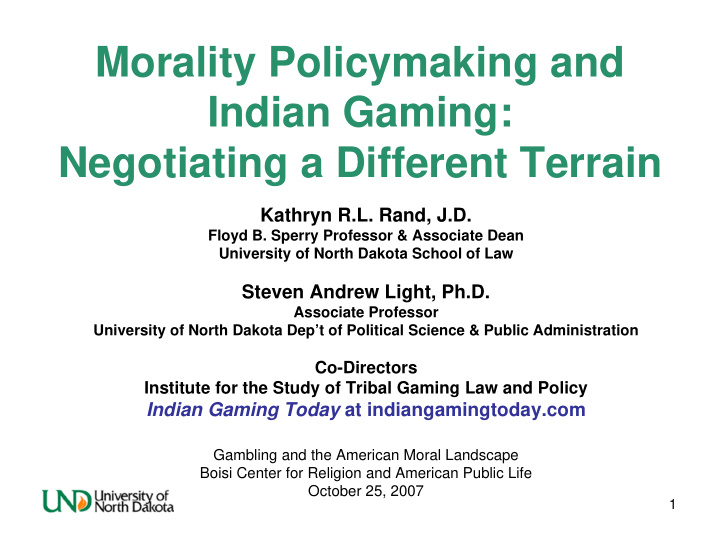



Morality Policymaking and Indian Gaming: Negotiating a Different Terrain Kathryn R.L. Rand, J.D. Floyd B. Sperry Professor & Associate Dean University of North Dakota School of Law Steven Andrew Light, Ph.D. Associate Professor University of North Dakota Dep’t of Political Science & Public Administration Co-Directors Institute for the Study of Tribal Gaming Law and Policy Indian Gaming Today at indiangamingtoday.com Gambling and the American Moral Landscape Boisi Center for Religion and American Public Life October 25, 2007 1
Institute for the Study of Tribal Gaming Law and Policy 2
I. Introduction 3
II. What Is Indian Gaming? Gaming conducted by “Indian tribe” on “Indian lands,” as defined by 1988 Indian Gaming Regulatory Act (IGRA) 4
Indian Gaming Industry • 30 states • 230 tribes • 400 gaming facilities • 2006 gross revenue: over $25 billion 5
States With Indian Gaming Source: Alan P. Meister, Indian Gaming Industry Report , 2007-2008 Updated Edition 6
Foxwoods Resort Casino Mashantucket Pequot Tribal Nation Ledyard, CT 7
Spirit Lake Casino & Resort Spirit Lake Nation Devils Lake, ND 8
Indian Gaming Operations By Revenue, 2006 Gaming Number of Revenue % Total % Total Revenue Operations (in millions) Operations Revenue $250 million or 23 11,214 5.9 44.7 more $100 million to 40 6,730 10.3 26.8 $250 million $50 million to 45 3,186 11.6 12.7 $100 million $25 million to 64 2,241 16.5 8.9 $50 million $10 million to 72 1,229 18.6 4.9 $25 million $3 million to 66 412 17.1 1.6 $10 million Under $3 77 61 19.9 0.2 million Total 387 25,075 100.0 100.0 Source : Rand & Light, Indian Gaming Law: Cases and Materials (2008) 9
III. Gambling Regulation 10
Three Regulatory Models • Commercial casinos – Nevada vs. New Jersey approach – Conducted by private sector • Charitable gambling and state lotteries – Limited gambling “for a good cause” – Public gambling • Indian gaming – Similar in scope to commercial casinos – Similar in purpose to state lotteries 11
A Brief History of Indian Gaming • California v. Cabazon Band of Mission Indians (1987) – Indian gaming is aspect of tribal sovereignty – States may not regulate Indian gaming • 1988 Indian Gaming Regulatory Act (IGRA) – Purposes: Promote tribal economic development, self-sufficiency, and strong tribal governments – Delegated some regulatory authority to states via tribal-state compact requirement for casino-style gaming 12
IV. Morality Policymaking and Legalized Gambling A. Process , or how gov’t considers gambling policy B. Outcome , or policy adopted by gov’t 13
Explaining the Process • Different policy generates different politics (Lowi) • Social regulatory or morality policy – Strongly held core values (religious beliefs) – Non-technical issues – High citizen interest and participation – E.g., abortion, capital punishment, GLBT rights, pornography, school prayer, gambling 14
Informing the Outcome • “Normal” vices, like gambling, don’t have clear moral consensus • Non-technical and uncompromising opinions influence outcomes – Policy decisions without good information • Policy outcomes are inconsistent, unpredictable, highly dynamic, and underinformed 15
V. The Different Terrain of Indian Gaming 16
Three Fundamental Differences • 1. Tribal sovereignty • 2. Indian gaming is public gaming • 3. Socioeconomic deficits of tribes 17
Tribal Sovereignty • Tribes: Extra-constitutional political entities • States ordinarily lack authority • Cabazon and IGRA recognize gaming as aspect of tribal sovereignty • State and federal control over tribe’s gambling policy decisions problematic 18
Indian Gaming is Public Gaming • IGRA’s goals: Promoting tribal economic development, self-sufficiency, and strong tribal governments • Akin to state lotteries, but broader in public policy scope: – Primary source of gov’t funding for many tribes – Job creation, economic diversification – Obligations of “full service” government; e.g., law enforcement, emergency services, public housing, social programs, cultural programs 19
Socioeconomic Deficits and Reservation Quality of Life • 1990 – 1/3 of American Indians live in poverty ( up to 60% in some communities) – Reservation unemployment exceeds 50% (up to 90% in some areas) – Extreme poverty linked to mortality rates, suicide, substance abuse, crime • 2000 – Some improvement – Indians still lag behind general population in most socioeconomic indicators 20
VI. Moral Policymaking and Indian Gaming 21
Explaining the Process • Indian gaming is technically complex issue • Strongly held convictions of state citizens influence tribal rights and tribes’ ability to effectively respond to members’ needs • Indians as “invisible minority” • Higher stakes for tribes & tribal members • Process must take into account differences 22
Informing the Outcome • IGRA grounded in Indian gaming’s differences • Importance of job creation & functioning economies • Tribal institutional capacity building • Cooperative policymaking • “Good” of Indian gaming must take into account benefits to tribal communities & reservation poverty and unemployment 23
Informed Moral Policymaking on Indian Gaming • 1. What is the moral responsibility of tribal governments to serve the public interest? • 2. What is the moral responsibility of non- tribal governments to serve the public interest, including that of tribal governments and tribal members? • 3. Indian gaming’s three differences should guide non-tribal governments’ moral policymaking re. tribal gaming 24
Morality Policymaking and Indian Gaming: Negotiating a Different Terrain Kathryn R.L. Rand, J.D. rand@law.und.edu Steven Andrew Light, Ph.D. steven_light@und.nodak.edu Co-Directors Institute for the Study of Tribal Gaming Law and Policy University of North Dakota Blogging at Indian Gaming Today indiangamingtoday.com 25
26
Recommend
More recommend